Zionist Advocacy (an eight-poster
series)
Artists: Students for Peace in the Middle East/takeACTIONnow.org
Publisher: The American Jewish Committee (AJC)
2003
These eight posters, made available as PDFs for use in hasbara (Hebrew: Israel advocacy, solidarity) activities on U.S. campuses, form part of a meticulously scripted “Information Kit for Campuses” underwritten by the American Jewish Committee (AJC). Created by a group called Students for Peace in the Middle East, these posters confirm organized Zionism’s selective filtering of history and language and its efforts to control the focus of debate.
The kit accompanying the posters is packed with organizing suggestions, related publications, history quizzes, web links, news reports, public speaking tips, and other media resources designed to support students as they “counter anti-Israel bias.” All major special interests groups such as the tobacco industry, the health insurance industry, the National Rifle Association, the pharmaceutical cartel, and the Christian right rely heavily on intense message management to defend against criticism. In the same way, this kit reflects a corporate approach to public relations, that is, an effort to script the message and regulate the images so as to take away opportunities for a thorough investigation of the facts. The impression of a corporate mentality behind these posters is reinforced by the fact that the AJC refers to them as ads and also by the observation that the information kit contains talking points from the advocacy group’s director plus a tip sheet on “effective communication” excerpted from a marketing manual.
The posters themselves are unremarkable and artistically disappointing. They violate many of the principles of good design in that they are heavily textual, employ dated photos, and lack graphic appeal.
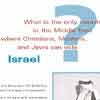 |
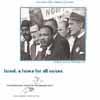 |
 |
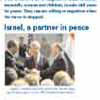 |
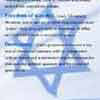 |
 |
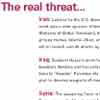 |
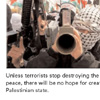 |
The textual points of each poster are written in a highly nuanced style, while the tone is unassailably reasonable. Each concludes with one of two sub-captions: “Israel, a home for all voices” and “No excuse for terrorism.” Together these slogans present the dichotomy of Israelis as democratic and Palestinians as dangerous. In sum, they are designed to put the best possible light on Israel and Zionism. For the uninitiated Jewish students at whom the posters are aimed, they will ring true. For those with a deeper understanding of contemporary Middle East history, these posters are classic examples of special interest misinformation. In support of this opinion, critiques of each poster are included at the end of this essay.
The tactics undergirding these posters are solidly analogous to those embraced by the pre-Civil War South in its attempts to thwart the spread of abolitionism. In that confrontation, the South’s chief advocate, John C. Calhoun — former Congressman and Senator from South Carolina, Vice President, Secretary of State, and intellectual eminence of the slave-owning class — authored the excruciatingly tortured logic of the “positive good” school of slavery. In his famous 1837 Senate speech, “Slavery As Positive Good,” he said:
I hold concession or compromise to be fatal. If we concede an inch, concession would follow concession — compromise would follow compromise, until our ranks would be so broken that effectual resistance would be impossible. We must meet the enemy on the frontier, with a fixed determination of maintaining our position at every hazard. We are now told that the most effectual mode of arresting the progress of abolition is to reason it down...(italics added)
The posters in this series are, above all else, an attempt to “reason down” criticism of Zionism. An information sheet in the kit encourages students to use these posters to open respectful dialogue as opposed to a debate but there is a disingenuousness about this advice. The information provided about the distinctions between debate and dialogue is helpful on its face: “This worksheet provides a basic outline of important points you should keep in mind in order to prevent your dialogue from turning into a debate.” The inference is that dialogue can be kept to the facts as presented in these posters; debate must be avoided because through it other facts and interpretations, unhelpful to Israel, could slip in.
An unstated premise of these posters, echoing an unstated premise of Calhoun’s rhetoric, is that it is heretical to challenge, dismiss, or criticize Zionism. In another accompanying document, “Tips for Pro-Israel Advocates,” AJC executive director David A. Harris says:
...If they reject Israel’s right to exist as a Jewish state, why? There are 191 members of the U.N. Do the critics challenge any other country’s right to exist, or only Israel’s? If the latter, then don’t hesitate to label this what it is – anti-Semitism. There is no other way to describe an attitude that uniquely denies to the Jewish people the right of self-determination that all other peoples seek.
This is a very disturbing piece of advice for the director of a major American Jewish organization to be giving to students he recognizes as untutored novices on the subject of Israel, Zionism, anti-Semitism, and the politics of the contemporary Middle East. In essence, Harris encourages pro-Israel students to level what is perhaps the most damaging personal charge imaginable — to be called an anti-Semite in public — against other students who may be equally untutored and who are seeking a public forum in which to learn about their country’s role in the Middle East. This ill-considered and misguided advice cannot have any effect other than to chill democratic debate on this important issue on American campuses.
In this sense too, the posters parallel the Calhounian tactic of putting slavery’s critics on the defensive by attempting to appropriate for themselves the moral high ground and then leveling the most damaging charges of the day at their opponents. The parallel charges in antebellum history would be: threatening the lives of white Southerners by making them the targets of freed slaves; committing treason because their fanaticism threatened the unity of the U.S. and sanctity of the Constitution; and deliberately promoting the merging of the two races (miscegenation).
Considered as an example of corporate media-speak, these hasbara posters are fascinating examples of special interest spin and damage control. By carefully choosing text and images that defend Israel’s right to exist — which is generally not what Americans are arguing about or against these posters serve to draw the conversation away from the real source of friction — which is the question of morality. Americans want to discuss the morality of organized Zionism and how it relates to the morality of their own pluralistic American democracy, in much the same way that non-slaveholding Americans, epitomized by the Quakers, compared the morality of the plantation slavocracy to their own in the period between independence and the Civil War.
Questions for A New
Democratic Discussion
1) A website listed in the kit (The Jewish Agency for Israel/Department of Jewish Zionist Education) poses this Frequently Asked Question (FAQ): “Aren’t these [Israel advocacy resources] all a bit one-sided?” The answer provided is: “Well, these are advocacy positions....” In a democracy, are proponents of a given position obligated to include an impartial mention of their opponent’s position in their advocacy presentations? If yes, why? If no, why not? In terms of scholarship, how important is it to provide context when phrasing a political position for consideration by college students?
2) Who are the Students for Middle East Peace? Is it important or even helpful to know the identities of and the background and political leanings of artists when looking at their work?
3) Imagine a series of hasbara posters that argued the case for Israel but that had as part of their design brief the requirement that they had to be completely even-handed. What would they look like? How might they read if the text came from empirical, scholarly sources such as the New Encyclopedia of Judaism or the Encyclopedia of the Palestinians?
4) In a recent speech at the National Endowment for Democracy (November 7, 2003), President George W. Bush pronounced a new “forward strategy of freedom in the Middle East.” This strategy would bring an end to American foreign policy that excuses and accommodates undemocratic regimes. The president also frequently hails Israel as the only “true” democracy in the Middle East. Why hasn’t Israel been an exporter of democratic principles and values to its neighbors since its independence in 1948? What problems might the U.S. face now as it tries to promote itself as an engine of democratic reform in the Middle East?
5) Assume that the Bush administration’s “forward strategy” works and all Arab nations develop robust and pluralistic democratic governments within ten or twenty years. Are the positions of those governments towards Israel likely to change? How might the United States evaluate its investments in democracy in the Middle East if Arab citizens participating as members of an authentic democracy, still choose to shun Israel economically, politically, diplomatically, and culturally?
6) Will Israel welcome the emergence of a truly democratic government in the envisioned Palestinian state? What kinds of problems might that pose for Israel? What kinds of advantages?
Related Works
A Victory for the Palestinian People
What is the only country in the Middle East where Christians, Muslims and Jews can vote? Israel
This poster attempts to place Israeli democracy on a par with that of the U.S. It states: “Israel is the only true democracy in the Middle East holding regular elections for all seats in its government.” That Israel holds regular elections is indisputably true. However, elections are not the defining hallmark of an authentically democratic state. The equality of all citizens under the law, is.
During the American Civil War (1861-1865), the Confederate States of American held regular elections and people from many different religious and ethnic backgrounds served in its government; yet few Americans think of the Confederacy as a real democracy. The Confederacy adopted a constitution that was almost an exact copy of the U.S. Constitution save for the fact that it included a clause legitimating human slavery. Yet a majority of the citizens of the North refused to recognize the Confederacy because it attempted to redefine democracy in such a way as to create separate classes based on race and because of its willingness to violently split apart the country to preserve its “peculiar institution.”
This poster would be accurate and transparent if it claimed Israel to be an ethnocracy with democratic forms, including free elections, a free press, an independent judiciary, freedom of religion, and a common franchise. But its claim that Israel is a “true democracy” is neither accurate nor transparent. Israel’s primary and immutable identity is as a Jewish state, not a democracy. By definition, the laws and practices of Israel give preference to its Jewish citizens.
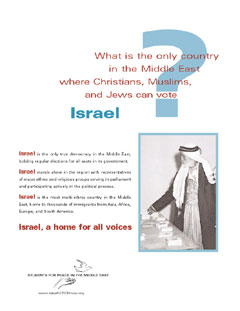
Proof that Israel wants peace
This poster lists a series of dates from 1948 to 2002 outlining concessions and treaties Israel has offered or signed in pursuit of peace.
THE CAPTION READS The list of dates begins at 1948, omitting any mention of pre-independence Israel or the series of events that led up to Arab resistance against the formation of an Israeli state in 1948.
The 1967 caption reads: “Immediately after fighting the Six-Day War, a struggle for its survival, Israel offers to exchange land obtained for peace. 8 Arab states issue the Khartoum Resolution: “no peace with Israel, not recognition of Israel, no negotiations with it.” That Israel hoped to exchange land for peace is a solid historical fact. However, to fail to mention any of the major historical factors, such as the fact that the Arab world was still reeling from the overwhelming defeat it had just suffered in the Six Day War; long running inter-Arab tensions and the impact of Cold War and superpower considerations, as explanations for the “three no’s” is, at best, spin.
The 1979 caption, “Israel gives the Sinai to Egypt after the two countries sign a peace treaty,” creates the impression of Israel offering a gift, when a more objective statement might have used the phrase “returns territory captured in war.” The 1993 caption states, “Prime Minister Yitzak Rabin signs a peace treaty with Yasser Arafat in Oslo.” The sub-caption bears no relationship, except to portray co-signer Arafat as a terrorist, when in fact after the Oslo signing the Middle East experienced its first period of stability and optimism since 1948. No mention is made of the fact that Arafat, along with Shimon Peres and Yitzak Rabin received the Nobel Prize for Peace for signing the Olso Peace Accords.
The year 2000 caption outlines Israel’s offer to establish a Palestinian state on 96 percent of the “disputed” territories. The sub-caption baldly adds, “Arafat rejected the plan.” No rationale is offered. The sub-caption continues, “The second intifada is launched and a wave of terror begins.” This suggests to readers that the second intifada occurred on Arafat’s orders. No mention is made of then-candidate for Prime Minister Ariel Sharon’s provocative visit to the Dome of the Rock mosque surrounded by, according to reliable press accounts, up to a thousand armed Israeli police. Even Zionists admit this was the “spark” that ignited the second intifada.
Of all the posters in this series, none more thoroughly demonstrates a shallower grasp of Middle East history than this one. Each of the entries is so biased and under-informed as to be meaningless in terms of describing actual events. No respectable university-level Middle East history course would grant a passing grade to the historical interpretations offered here.
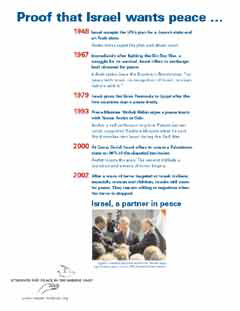
The Real Threat…
The objective of this poster is to portray Israel and the United States as together both in the risks they face from terror and in the war they wage against it. It presents Iran, Iraq, and Syria as “the real threat.” The implication is that Israel is not the threat to peace – a curious inference, since most Americans do not see Israel as a threat, even as they condemn certain of its policies and practices. The inference may perhaps be designed to reinforce the “with us or against us” strategy of hasbara argument. Evidence that this strategy is at work is found in the summaries of Iran, Iraq, and Syria as states that seek to harm Jewish people and destroy Israel. No right-minded American would identify with such fanatical hatred; the inference, however, is that in order to stand against it, one must stand with Israel. Incidentally, a recent European Commission poll found that 59% of those Europeans polled consider Israel to be the greatest threat to world peace, ahead of North Korea, Afghanistan and Iran.
Source: “Israel Outraged as EU Poll Names It a Threat to Peace”, The Observer, November 2, 2003
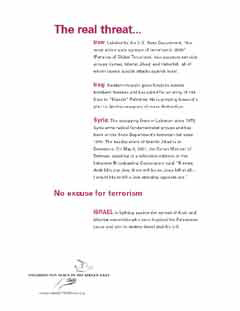
Why We Stand Behind Israel…
This poster features a laundry list of positive aspects of Israeli political culture — diversity, a free press, freedom of religion, and democracy — all of which are indisputably present. Yet what is important is what is omitted — the history behind the building of Israel, its cost to the indigenous Palestinians, the logic behind the Palestinians’ seeming unreasonableness in its relationship with Israel, and the deep, festering schisms that run through Israeli society. This poster could have been produced for Yugoslavia under Tito, which qualified to make an identical claim to be a model of ethnic and religious harmony. Once Tito’s dominant, controlling hand was removed, however, Yugoslavia erupted into a bloody and horrifying ethnic conflict. This poster is little more than an exercise in political denial.
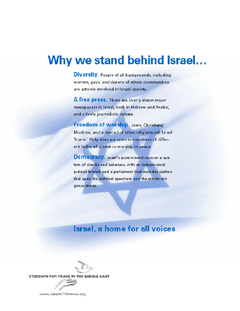
Martin Luther King Stood Behind Israel...Why?
This poster taps the still-mythic magnetism of King. It features his photograph at a U.S. civil rights rally and the following quote:
I see Israel, and never mind saying it, as one of the great outposts of democracy in the world, and a marvelous example of what can be done, how desert land can be transformed into an oasis of brotherhood and democracy. Peace for Israel means security and that security must be a reality.
March 25, 1968, the 68th annual convention of the Rabbinical Assembly
King was well versed in Jewish history and frequently made impassioned comparisons to the suffering and injustice that mark both African-American and Jewish histories. King also was an active supporter of the anti-apartheid movement in South Africa, often comparing the oppressive apartheid regime to the anti-black and anti-Jewish racism of the Ku Klux Klan.
King died in 1968. One might wonder what he would say about Israel today. His brother-in-arms, Nobel Peace Laureate Reverend Desmond Tutu of South Africa, echoed King’s deep respect for Israel while also saying this about the anti-occupation boycott against the country:
To criticize the occupation is not to overlook Israel’s unique strengths, just as protesting the Vietnam War did not imply ignoring the distinct freedoms and humanitarian accomplishments of the United States. In a region where repressive governments and unjust policies are the norm, Israel is certainly more democratic than most of its neighbors. This does not make dismantling the settlements any less of a priority.
Source: “Build Moral Pressure to End the Occupation," International Herald Tribune, June 14, 2002
In the same article, Tutu stated that Nelson Mandela, the liberation hero of South Africa, shared his view that the boycott had much in common with the anti-apartheid movement.
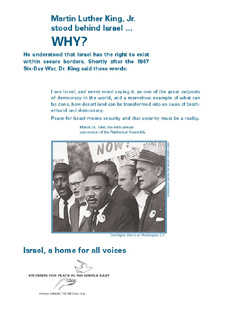
Does this sound like a two-state solution to you?
This poster carries a photograph of a kaffiyeh-clad Palestinian aiming a shoulder-mounted rocket launcher directly at the viewer and a much-publicized excerpt from the Hamas charter declaring that Islam will obliterate Israel. This is yet another topic that needs to be discussed more honestly and transparently in the U.S. Israel indisputably faces a major, perhaps unsolvable, problem with Hamas and its supporters. Hamas is the main dispatcher of suicide bombers and it is a key player, albeit as spoiler, in any Palestinian-Israeli peace process. It is not a negotiating partner.
Americans are, or ought to be, indifferent to which political solution brings peace to Palestinians and Israelis. That is for the two peoples to decide. Whether the involved parties advocate one state or two states, a confederated state, a cantonal model, or any other geo-political combination, is not the real question that comes to mind with this picture. The real question is, who created Hamas? And the answer is, Israel.
Israel gave Hamas legitimacy when it recognized it as a registered charity in 1978. At the time, Israel was looking for an apolitical domestic force capable of neutralizing the popularity of the Palestine Liberation Organization (PLO) in the refugee camps and among the wider populations of the West Bank and Gaza. During its formative years, Hamas, with its schools, day care centers, vocational training institutes, lunch programs, hospitals, and other social services was functionally indistinguishable from Jewish aid societies active among the poor in the U.S, Europe, and Israel such as the Jewish Relief Agency. Hamas’ original name was Al Mugamma’ Al Islami (Arabic: The Islamic Society).
From its roots as a social services agency serving the working poor of Gaza, it evolved into a political, and ultimately military, force. Israel badly misjudged the consequences — for itself and secular Palestinian society — of legitimating a community-based, religiously oriented Palestinian agency situated at the center of an insurrection-prone exile population held in involuntary confinement. This mistake evokes Thomas Jefferson’s famous 1820 cautionary letter, “A Fire Bell in the Night.” This prescient letter outlined the disastrous likely consequences that would result from the failure of the Constitutional Congress to address the issue of slavery. Jefferson wrote:
... But this momentous question [slavery], like a fire bell in the night, awakened and filled me with terror. I considered it at once as the death knell of the Union. It is hushed, indeed, for the moment. But this is a reprieve only, not a final sentence. A geographical line, coinciding with a marked principle, moral and political, once conceived and held up to the angry passions of men, will never be obliterated; and every new irritation will mark it deeper and deeper... But as it is, we have the wolf by the ears, and we can neither hold him, nor safely let him go. Justice is in one scale, and self-preservation in the other.
Israel, with its prodigious military might, unquestionably has the Palestinian wolf by the ears. This is a problem of its own making, and Americans should not be deluded about this.
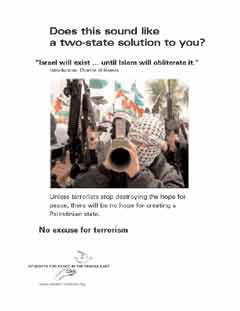
Myth: Palestinian suicide bombers are driven to murder by poverty and destitution.
The simplistic analysis that Palestinian suicide bombers are motivated by hatefulness and racism serves no purpose except to promote the concept of Palestinian wantonness. Suicide bombings mark an apocalyptic turning point in the Palestinian-Israeli conflict. These unspeakably violent, nihilistic acts surely stem from psychological and political sources more complex then those put forward by a group of ingenuous American university students.

What do they teach in school?
This poster compares single lines from Israeli and Palestinian textbooks. The excerpted passage from the Israeli textbook is uplifting, while the one from the Palestinian textbook is troubling indeed. Textbook content deserves more attention from Americans, especially since the U.S., via the Oslo Peace Accords, has supported the Palestine Authority’s revision of its schoolbooks and curricula. Yet insightful analysis cannot be based on single lines of text. Many studies have been conducted about both Israeli and Palestinian schoolbooks; the assessments have been contradictory and inconclusive. Before casting judgment, Americans deserve a fuller view of the contents of textbooks from both cultures.
Readers interested in learning more about hasbara positions are referred to The Case for Israel, by Alan Dershowitz (John Wiley & Sons, 2003).

Please send us your questions and comments (English only please!)
www.liberationgraphics.com